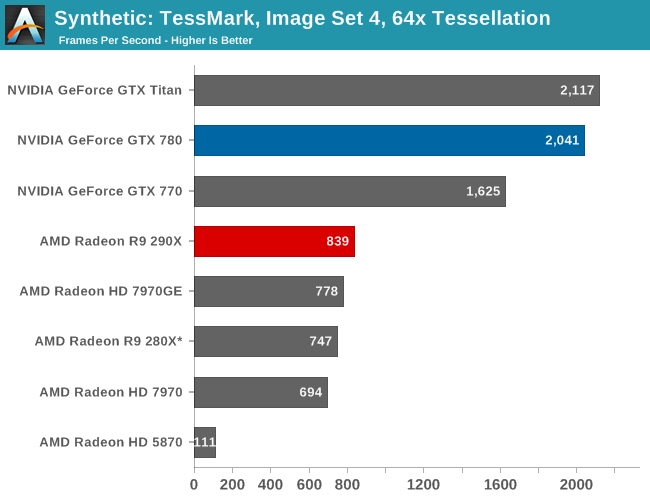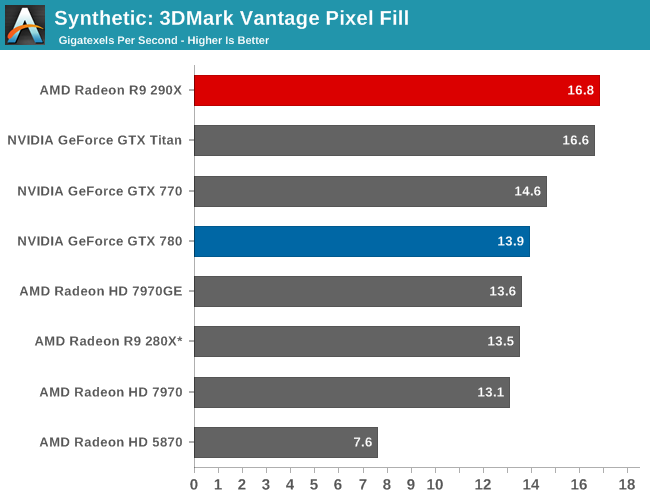The AMD Radeon R9 290X Review
by Ryan Smith on October 24, 2013 12:01 AM EST- Posted in
- GPUs
- AMD
- Radeon
- Hawaii
- Radeon 200
Synthetics
As always we’ll also take a quick look at synthetic performance. The 290X shouldn’t pack any great surprises here since it’s still GCN, and as such bound to the same general rules for efficiency, but we do have the additional geometry processors and additional ROPs to occupy our attention.

Right off the bat then, the TessMark results are something of a head scratcher. Whereas NVIDIA’s performance here has consistently scaled well with the number of SMXes, AMD’s seeing minimal scaling from those additional geometry processors on Hawaii/290X. Clearly Tessmark is striking another bottleneck on 290X beyond simple geometry throughput, though it’s not absolutely clear what that bottleneck is.
This is a tessellation-heavy benchmark as opposed to a simple massive geometry bencehmark, so we may be seeing a tessellation bottleneck rather than a geometry bottleneck, as tessellation requires its own set of heavy lifting to generate the necessary control points. The 12% performance gain is much closer to the 11% memory bandwidth gain than anything else, so it may be that the 280X and 290X are having to go off-chip to store tessellation data (we are after all using a rather extreme factor), in which case it’s a memory bandwidth bottleneck. Real world geometry performance will undoubtedly be better than this – thankfully for AMD this is the pathological tessellation case – but it does serve of a reminder of how much more tessellation performance NVIDIA is able to wring out of Kepler. Though the nearly 8x increase in tessellation performance since 5870 shows that AMD has at least gone a long way in 4 years, and considering the performance in our tessellation enabled games AMD doesn’t seem to be hurting for tessellation performance in the real world right now.
Moving on, we have our 3DMark Vantage texture and pixel fillrate tests, which present our cards with massive amounts of texturing and color blending work. These aren’t results we suggest comparing across different vendors, but they’re good for tracking improvements and changes within a single product family.

Looking first at texturing performance, we can see that texturing performance is essentially scaling 1:1 with what the theoretical numbers say it should. 36% better texturing performance over 280X is exactly in line with the increased number of texture units versus 280X, at the very least proving that 290X isn’t having any trouble feeding the increased number of texture units in this scenario.

Meanwhile for our pixel fill rates the results are a bit more in the middle, reflecting the fact that this test is a mix of ROP bottlenecking and memory bandwidth bottlenecking. Remember, AMD doubled the ROPs versus 280X, but only gave it 11% more memory bandwidth. As a result the ROPs’ ability to perform is going to depend in part on how well color compression works and what can be recycled in the L2 cache, as anything else means a trip to the VRAM and running into those lesser memory bandwidth gains. Though the 290X does get something of a secondary benefit here, which is that unlike the 280X it doesn’t have to go through a memory crossbar and any inefficiencies/overhead it may add, since the number of ROPs and memory controllers is perfectly aligned on Hawaii.










396 Comments
View All Comments
Notmyusualid - Friday, October 25, 2013 - link
I have to admit the lower power consumption of the Titan would draw me in. Electricity costs are a joke in the UK now.Sancus - Thursday, October 24, 2013 - link
haha, awesome.hoboville - Thursday, October 24, 2013 - link
Great review Ryan, always in depth and insightful.One of the things I have noticed over the years is that, depending on the card (core count / TDP) the reference blower is rarely ever better than aftermarket coolers made by ASUS, EVGA, etc (anyone else confirm / deny?). That is to say they seem to provide both less cooling and more noise. My concern is that the 290X is hitting 90 degrees C. Some people who have warmer residences may find themselves having trouble. Hopefully AMD will let their partners start making custom coolers by Black Friday!
With regards to the price / performance, this reminds me of how the EVGA 780 Superclocked ACX (I think) blows away the Titan by being nearly as fast and so much cheaper. I've heard rumors that AMD may be extending their Never Settle Forever bundle to Hawaii, have you heard anything new about this? None the less, the value of an OC'd 780 would seem to be the same if the buyer were to Ebay off those game keys. Hopefully the 780 Ti will drop the 780 down to a reasonable price w/ game bundle, again giving us consumers more for our money.
Two quick questions: How well does the 290X do for Litecoin / BTC? Will the XFX 290R include Battlefield 4?
FriendlyUser - Thursday, October 24, 2013 - link
Great price and performance. Thanks for the timely review. I think this is a halo product, whose main role is to humiliate the Titan. The most interesting deal should be the 290 with a non-reference cooler.g00ey - Thursday, October 24, 2013 - link
Well it certainly killed my boxers, that's for sure...Thomas1016 - Thursday, October 24, 2013 - link
I bought a r9 290x this morning from Newegg. The bundled version is 579.00 the none bundled is 549.00 so the price that were quoted were in fact accurate.The one thing that does concern me a little is only having 1 fan on the card. But I also don't plan on tweeking it much if at all.
Shadowmaster625 - Thursday, October 24, 2013 - link
This gpu has such good memory bandwidth... so why dont they just shove 3 steamroller modules in there and slap on a southbridge and make it into an elite gaming PC motherboard? It wouldnt cost them much more than $100 extra to make this video card into a complete PC motherboard. The transistor count would only increase by 25%, so power would probably stay under 400W.Kevin G - Friday, October 25, 2013 - link
3 Steamroller modules would make the die size go beyond what is manufacturable. Three modules would add ~90 mm^2 to the 428 mm^2 dies without any support logic and before the south bridge was added. When all is said and done, the die size would likely be north of 600 mm^2.Power draw under full load would easily exceed 450W. The only way to move that much heat would be liquid cooling. Including the south bridge would add too many IO pins on top of an already large IO configuration.
labotsirc - Thursday, October 24, 2013 - link
Does anyone now if the 290X will support OpenCL 2.0, with the new dynamic parallelism feature?If yes, then i could buy 2 of these instead of one Titan, which does support this feature.
kyuu - Thursday, October 24, 2013 - link
The conclusion here is that this is a great card at a great price, but you should wait for custom cooling solutions since the reference cooler is inadequate. Unless you are going to build your own cooling solution or simply MUST have the fastest single-GPU card right now.